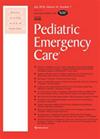测量大型学术三级医院儿科急诊室的拥挤程度。
IF 1.2
4区 医学
Q3 EMERGENCY MEDICINE
引用次数: 0
摘要
目的:过度拥挤评分在成人急诊科(ED)中得到了广泛的研究,但很少有研究确定其在儿科环境中的实用性。本研究的目的是在一个大型学术性三级医疗机构儿科急诊室中,确定修改后的国家急诊室过度拥挤评分(mNEDOCS)与既定急诊室指标之间的关联。使用电子病历对 2016-2019 年间每次急诊就诊的患者特征、急诊室处置、急诊室停留时间(LOS)、未就诊离开率(LWBS)、住院时间(HLOS)、72 小时内急诊室返回率和 mNEDOCS 进行了回顾性采集。结果修正后的 NEDOCS 与 ED LOS、LWBS 和 72 小时内回访率呈正相关。mNEDOCS 与 HLOS 呈负相关。在控制某些协变量的情况下,mNEDOCS 的类别每增加一个,LWBS 的几率就增加一倍(几率比为 2.03;95% 置信区间 [CI],2.00-2.06)。当 mNEDOCS 类别每增加一个类别时,72 小时回访的几率增加 6%(几率比 1.06;95% 置信区间 [CI],1.05-1.07)。在控制协变量的情况下,mNEDOCS类别每增加一个类别,住院时间就会减少100分钟(β = -99.85;95% CI,-180.68至-18.48)。要阐明 mNEDOCS 与 HLOS 之间的关系,还需要进一步的研究。本研究说明了 mNEDOCS 作为儿科急诊室过度拥挤度量指标的实用性。本文章由计算机程序翻译,如有差异,请以英文原文为准。
Measuring Overcrowding in a Large Academic Tertiary Care Pediatric Emergency Department.
OBJECTIVE
Overcrowding scores have been studied extensively in adult emergency departments (EDs), but few studies have determined utility in the pediatric setting. The objective of this study was to determine the association between a modified National Emergency Department Overcrowding Score (mNEDOCS) and established ED metrics in a large academic tertiary care pediatric ED.
METHODS
NEDOCS was modified to increase applicability in the pediatric setting by including the number of patients in resuscitation rooms instead of a number of patients on ventilators. Patient characteristics, ED disposition, ED length of stay (LOS), rate of left without being seen (LWBS), hospital LOS (HLOS), ED returns within 72 hours, and mNEDOCS were acquired retrospectively for every ED encounter in 2016-2019 using the electronic health record. Descriptive statistics, Spearman correlation, and multivariate analyses were calculated to evaluate the association between specific ED metrics and mNEDOCS.
RESULTS
Modified NEDOCS positively correlated with ED LOS, LWBS, and rate of 72-hour return visits. A negative correlation was found between mNEDOCS and HLOS. When controlling for select covariates, the odds of LWBS doubled with each increase in mNEDOCS category (odds ratio, 2.03; 95% confidence interval [CI], 2.00-2.06), ED LOS was associated with an increase of 27 minutes as mNEDOCS category increased (β = 26.80; 95% CI, 26.44-27.16), and the odds of 72-hour return visits increased by 6% when mNEDOCS increased by one category (odds ratio, 1.06; 95% CI, 1.05-1.07). Hospital LOS was associated with a 100-minute decrease per increase in mNEDOCS category (β = -99.85; 95% CI, -180.68 to -18.48) when controlling for covariates.
CONCLUSION
Modified NEDOCS is positively associated with ED LOS, LWBS, and 72-hour return visits, consistent with adult data. Further investigation is needed to elucidate the association between mNEDOCS and HLOS. This study illustrates the utility of mNEDOCS as a measure of overcrowding in a pediatric ED.
求助全文
通过发布文献求助,成功后即可免费获取论文全文。
去求助
来源期刊

Pediatric emergency care
医学-急救医学
CiteScore
2.40
自引率
14.30%
发文量
577
审稿时长
3-6 weeks
期刊介绍:
Pediatric Emergency Care®, features clinically relevant original articles with an EM perspective on the care of acutely ill or injured children and adolescents. The journal is aimed at both the pediatrician who wants to know more about treating and being compensated for minor emergency cases and the emergency physicians who must treat children or adolescents in more than one case in there.
 求助内容:
求助内容: 应助结果提醒方式:
应助结果提醒方式:


